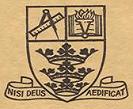
SIR CHRISTOPHER WREN TECHNICAL HIGH SCHOOL

THE DRAWING BOARD
When we look at our world wherever we are, we see creations by nature and creations by man. In our city around our school we see blocks of flats, a new cinema, a church, a road cutting and many other objects, all made to improve our living or make it more comfortable and happier. All of these achievements started in some form or other on the drawing board and were created by someone who was once a nervous or mischievous youngster. The subject of drawing, at one time a recreational study, is in these days of Technical Education one of the main subjects in a course of studies. Drawing is co-related with many other studies such as Workshop Practice, Science in the Laboratory, Building Construction, Practical Geometry and Practical Surveying. The last three subjects are those which depend so much on the ability of the student to produce a drawing portraying objects which are visualised and which may have to be constructed or created.
The aim of the school from the drawing board point of view is therefore a scheme of drawing office practice which in turn embraces the three main subjects, Building Construction, Practical Geometry and Practical Surveying.
The Building Construction course consists of making drawings of parts of a building, learning the different kinds of material which make these constructions and producing an elementary working drawing. This course will eventually cover four years and will link up with the geometrical drawing for the G.C.E. O. Level. In the Practical Geometry course the basic principles of all angles of projections of solids and the construction of plain figures are learnt. This course will be of five years duration and in the latter two years may have a bias towards Building or Metalwork and elementary machine drawing.
In the practical surveying course, although we have already had successes at ‘O’ Level in one year, we intend to widen this to two years. This course consists of the use of instruments for measuring, levelling and taking bearings, etc., on sites about the school and other more suitable sites. From the measurements taken drawings are made and tracings produced which in turn are used for obtaining prints and these are tinted and entered for course work at ‘Ord’ level.
This is but a brief outline of the elementary stages of the drawing board, without which even the ‘cornerstone’ cannot be laid without security and promise.
Mr. C.H. Sugden
WHISPERINGS FROM THE WOODWORK SHOP
By:- the man in charge
It was suggested to me, that perhaps I would like to contribute a script towards our school magazine. This suggestion came from our most noble English Master who towered over me, speaking with dulcet like tones, naturally using impeccable English. Of course I readily agreed (no choice, he weighs two and a half stones more than I) and went blithely on my way. After the lapse of a few days, with a pleasant weekend between, Monday morning came around, and with it a surprise. I am now confronted with a 6’ 2” prefect, who politely enquires if my masterpiece is ready, to which I replied “No”. The prefect, still extremely polite, gives me 48 hours to produce one and so I resolve to get cracking (Oh! What English!), that very night.
Although the moon is not yet up, I think the time has come to mention the woodwork shop. Having completed two years at the High School for Building, and had before me the faces of some 180 boys, an odd mention here and there, could, I think, be allowed. As our intake comes from schools in all parts of the city, it is natural, for quite a variation in ideas. To obtain the information I need as to what the boys have done previously, I ask a few questions, and get the most remarkable replies. As each boy is asked to state whether he has done woodwork before or not (a surprising number had not) and to tell me what he has made, the replied are always progressive. “We start with a simple job like a nail box and finish up with a coffee table, dining chairs, sideboards and the odd bedroom suite”. This pleases me (simple soul), and I can see that to turn these boys into a Sheraton or Chippendale will not require much instruction on my part. I now have decided on my line of action - a simple job, involving a mortise and tenon, just to test each lad’s ability. After much talking and demonstrating, the boys are very keen to start, and so I unleash them on their course of destruction. As some of you first year boys know now, the idea is for the tenon to fit tightly into the mortise, and not to leave enough room for a trowel full of Mr. J. Redhead’s super, smooth, marvelous mortar. With the new of the school year so close, I can see the odd diamond here and there, and quite a few who will most likely PULL UP THEIR SOCKS during the second year.
The present 2nd year have produced some excellent stools, and a large percentage of these boys are really skilful with their hands. Alas there are those who seem to delight in being potential firewood merchants (THEY KNOW WHO THEY ARE-).
Now to our gentlemen in the 3rd year, who have produced some really fine models, and designed them too. To those of you who saw this work, and undoubtedly admired it, this high standard which YOU must attain, can be done by getting on with your own task.
I take this opportunity of saying to the five G.C.E. Candidates how pleased I was with your efforts, and that Mr. Drayton, the visiting examiner make some good comments on everything he saw and special reference to the high standard of draughts-manship . Unfortunately, some comments were adverse on handling of tools (future candidates note). Who chopped with a chisel where a saw would have should have been used? Who squared marks over with a rule? Who left his plane, with the sole on the bench? Who left a chisel projecting from the bench for anyone to walk into?
To those of you who are leaving, evening classes are run for almost any subject necessary for your advancement, and employers are still looking for the lad who is keen to get on, and maintain the effort to a certificate of some standing.
I shall be pleased to see any O.B. in future years, and having spend a number of years in the Building industry in varying capacities, could possibly offer a little advice (if required) to anyone entering this industry.
Finally, before the ink shortage overtakes me - happy holiday - success in your careers, and to those remaining - see you in September.
Mr. G.W. Wallis